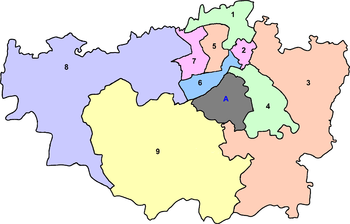Heera Mandi
Heera Mandi (Urdu and Punjabi: ہیرا منڈی; meaning "Diamond Market"), sometimes referred to as Shahi Mohallah ("Royal Neighbourhood"), is a neighbourhood and bazaar, specifically known as red light district of Lahore.[1][2]
Heera Mandi ہیرا منڈی | |
|---|---|
| Country | |
| Province | Punjab |
| City | Lahore |
| Administrative town | Ravi |
| Union council | 30 (Taxali Gate) |
It is located inside the Walled City of Lahore, near the Taxali Gate,[3] and south of the Badshahi Mosque. The market had historically been the centre of the city's refined tawaif culture since the 15th and 16th centuries.[4]
Etymology
The area's name is traditionally described by locals to describe the beauty of the girls in the market, as the word Heera means "diamond" in Urdu. The market is named after Heera Singh, who was the son of a minister of Ranjit Singh's court.[3] The neighbourhood is sometimes also referred to as Shahi Mohalla ("The Royal Neighbourhood"), given its close proximity to the Lahore Fort.
Historical background
The market was originally the centre of the city's tawaif (concubine) culture for the Lahore's Mughal era elite during the 15th and 16th centuries.[4] The neighbourhood became a centre for mujra - a sensual South Asian dance style that required years of practice to perfect.[4]
Under the British colonial rule, it became a hub of prostitution. Within the market, women and khusra (transgenders) offered traditional and classical dances. From the British colonial period till past few years, it remained a centre of prostitution in Lahore.[5] Many Hijras, members of Pakistan's transgender community, frequent the area and are involved in the area's dance culture.
Prostitution
The brothel houses were first developed by the British in old Anarkali Bazaar for the recreation of the British soldiers during the British Raj. After that these were shifted to Lohari Gate and then to Taxali Gate.[3] After 1947, many governments have made efforts to increase amenities for customers of prostitution at the Heera Mandi area of Lahore but have failed.
During the Zia era, an operation was conducted against music and dance houses, which were alleged to be dens of prostitution. The operation served to spread the practice throughout the city.[3] In recent times, the area has become known for prostitution again,[3] though the practice in the neighbourhood is in decline with the rise of online escort services.[4]
During the day, Heera Mandi is much like any other Pakistani bazaars and is known for its good food, wide range of Khussa (traditional Mughal footwear) and shops for musical instruments. At night, the brothels above the shops open. The place is also considered as a symbol for the city of Lahore and sometimes the words 'Heera Mandi' themselves are considered to be offensive in formal talks.[3]
Civic administration
The neighbourhood forms part of Taxali Gate's Union Council 30.
Cultural Portrayal
Heera Mandi is referred to in the Bollywood movie Kalank.
See also
References
- Jalil, Xari (30 April 2017). "FADE FROM RED: THE DIAMOND OF LAHORE HAS DULLED". DAWN.COM.
- "Heera Singh's Mandi - Pakistan Today". www.pakistantoday.com.pk.
- Zohaib Saleem Butt, "Heera Mandi: Scarlet secrets of Lahore", The Express Tribune newspaper, Published 20 August 2010, Retrieved 18 February 2017
- "How Facebook is killing Lahore's Heera Mandi". Dawn. AFP. Retrieved 7 October 2017.
- Grimes, William (July 20, 2005). "In Shadows of a City of Pleasure, Courtesans Grow Old". The New York Times newspaper. Retrieved 18 February 2017.
Further reading
- Saeed, Fouzia (2001). Taboo!: The Hidden Culture of a Red Light Area. Karachi: Oxford University Press. ISBN 978-0-19-579412-0.
- Saeed, Fouzia (2006). "Chapter 6: Good women, bad women: prostitution in Pakistan". In Gangoli, Geetanjali; Westmarland, Nicole (eds.). International Approaches to Prostitution: Law and policy in Europe and Asia. The Policy Press, University of Bristol. pp. 141–164. ISBN 978-1-86134-672-8.*Brown, Louise (2006). The Dancing Girls of Lahore: Selling Love and Saving Dreams in Pakistan's Pleasure District. Harper Perennial. ISBN 978-0-06-074043-6.
- Khan, Noor Mohammad (2009). Some Time On the Frontier-A Pakistan Journal. CreateSpace. ISBN 978-1-4404-1597-5.
